Bilingual Brussel/Bruxelles (11/06/03)
Last updated 11/13/03
Brussels, the capital of Belgium,
sits right at the divide between Dutch-speaking northern part
(Flanders) and French south of the country (Wallonia), which are now
two fairly autonomous states with separate provincial governments.
Positioned at the watershed (although still more in the Flemish
community), Brussels proudly presents all signs, including street
names, in both official languages of Belgium, which makes room for much
confusion of visitors. For instance, the main square of the city, and
by some accounts the most beatiful central square in all of Europe, is
known as Grand Place in the French spelling, but Grote Markt in
Dutch... We almost got lost on the way back to the hotel at night,
although we just had to follow Rue Royal for most of its length,
because a careless glance at the street sign may suggest that you are
on Koningsstraat instead of Rue Royal, and only proficiency in both
French and Flemish (well, German at worst) will help determine that
both names refer to the same street.
Grand Place is indeed a very nice
square, surrounded by heavily gilded buildings, but I would hesitate to
hand it the title of the grandest central square in Europe; I tend to
think that quite a few other cities - from Prague to Brugges - could
compete in this area. Most buildings on Grand Place were constructed as
guildhouses, i.e. headquarters of wealthy merchant associations
(guilds). The square itself dates back to 12th century, but guildhouses
were rebuilt after being bombed into oblivion in 1695 by the French.
Amusingly, the main target of the bombing -- the city hall (Hotel de
Ville) -- survived intact, and is the only original builidng on the
square. Its gothic beauty is matched by the creme-colored building on
the opposite side of Grand Place, with a 100-meter-high tower. We
believe that most of these buildings are now in use by the city
administration, office of tourism and some hotels; the ground floor is
taken up by restaurants and cafes, all of which have outdoor terrace
seating with a great view of the square.
Grand Place was once a central
marketplace of the town, as witnessed by the names of streets that
extend from it: Rue des Bouchers (butcher's street), Rue de Beurre
(butter street) etc. Today Rue des Bouchers is lined with restaurants,
and nothing but restaurants: every door and window presents a menu and
invites you to a pricey meal of traditional Belgian dishes such as
mussels in white wine. Of course the whole place is a tourist trap with
barely any decent restaurants, and those of us with smaller appetites
and tighter wallets stick to fast-food sandwiches, since baguettes here
are as good as in France. One great sandwich chain we discovered is
called Panos, they have a tasty selection with some local
peculiarities: they use cocktail onions instead of the usual fresh-cut
ones, and include boiled egg in their vegetarian sandwich. Well, Europe
still thinks that fish is vegetarian, so what can you expect...
For a premium shopping experience
(or window-shopping, at the very least), Galeries St.Hubert are the
place to be. This is the oldest shopping gallery in Europe with a
skylight-type glass ceiling. Among other elite stores, it hosts the
Neuhaus which is, despite the "new" in its name, one of oldest
chocolate shops in Belgium. The presentation of their chocolates
matches the quality: the shopwindow is a genuine masterpiece with
chocolates and candy of all forms and colors. Too bad photography is
not welcome there. As an interesting gift for our friends, we got a
"Christmas calendar" from Neuhaus: it's a wall calendar with 24 windows
(for each day from December 1st to the Christmas Eve), and you are
supposed to open one window each day and eat the chocolate hidden
behind it. Or, if you are impatient, you can imagine that it's one
chocolate for each of the 24 hours of the day :-)
Finally, let me describe the
impression made by the most famous statue of Brussels, known as the
self-proclaimed symbol of the city: Manneken Pis, that is, "the peeing
boy". This sculpture is truly unforgettable in its disappointing
effect, because it is SO SMALL. Even if your guidebook tells you so in
advance, you really cannot prepare yourself for this sight. The thing
is tiny and utterly insignificant! Yes, it's a statue of a small boy
urinating into a small basin, and that's really all it is. The legend
behind the statue is confusing and thus dubious: it's either a boy who
extinguished some fire in the city, or a child of a local nobleman. The
only confirmed fact is that the current bronze statue was sculpted in
1619, and a stone version had been in the same spot from the 14th
century. Of course, the issue is hyped out of proportion, and in
souvenier shops you can buy chocolate coins with Manneken Pis,
keychains, bottle openers, fridge magnets, lollipops, other countless
imitations and copies of the statue in all sizes (including ones much
bigger than the original). I'm only glad that there was nothing else
disappointing about Brussels, once you've come to accept Manneken Pis
for what it is.
Now my 2 cents on Brussels.... Daria
is on the mark about the Manneken Pis -- there's a reason why on the
Belgium section of Europe on
a Shoestring they list just one thing to "avoid at all costs"
and that is the Manneken Pis -- it also calls it a "feeble tourist
attraction" which is a compliment in my opinion! Other than that, I was
beginning to feel that Belgium doesn't give much love to PLUS or
INTERLINK (the 2 card systems supported by our Bank of America ATM
card) until we arrived in Brussels. We were finally able to withdraw
cash from a CitiBank ATM near the train station, so if any of you
visitors to Belgium want to know an ATM that'll give you money, give
that one a try. By the way, as another rant on the Manneken Pis,
there's also a female version of that statue called Jeanneke Pis -- I'm
so glad that we didn't visit that one too.
Pictures
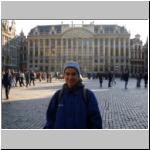
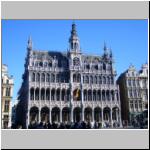
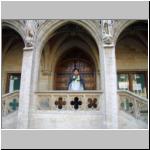
 Buildings on Grand Place
Buildings on Grand Place
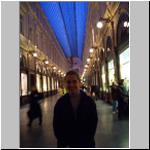
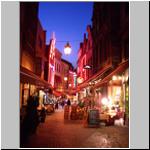
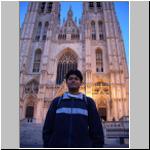 Where to indulge in shopping and dining, then atone for
those sins
Where to indulge in shopping and dining, then atone for
those sins
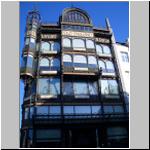

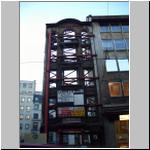 Odds and ends of Brussels architecture (left) and
sculpture
(below)
Odds and ends of Brussels architecture (left) and
sculpture
(below)
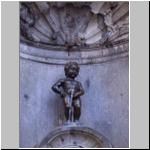
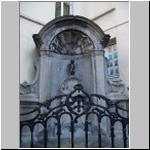
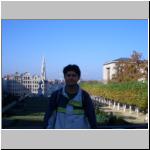
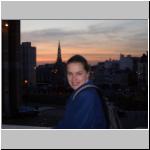



 Buildings on Grand Place
Buildings on Grand Place

 Where to indulge in shopping and dining, then atone for
those sins
Where to indulge in shopping and dining, then atone for
those sins

 Odds and ends of Brussels architecture (left) and
sculpture
(below)
Odds and ends of Brussels architecture (left) and
sculpture
(below)


